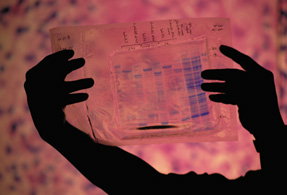Assess statin-associated myalgia on a patient-by-patient basis
Statin-associated muscle pain is controversial and poorly understood. But the consequence of stopping cholesterol drugs has a much clearer downside. Counsel patients on potential side effects, and let them know that switching is preferable to stopping.
Statin-associated myalgia occurs in about 1% to 3% of patients in the medical literature, but that figure is likely not a true representation of the occurrence of muscle pain, according to David Becker, MD, a cardiologist with Temple University Health Systems in Flourtown, Pa.
“In real-life situations, studies suggest that the occurrence is anywhere from 10% to 20%,” Dr. Becker said. In addition, he noted, the actual incidence of myalgia is difficult to measure.

“The true definition of statin-associated myalgia is controversial,” Dr. Becker said. “Some physicians suggest that true myalgia is only present if muscle pain or cramping has occurred on multiple statins, and improves after each statin is discontinued. Less strictly defined, myalgia is present if a patient complains of muscle aching after a few weeks of initial statin therapy. In this case it is the patient who often defines myalgia by either stopping or refusing further therapy.”
Myalgia is more common in patients with low body mass. Myalgia is also more common in Asian populations because of a genetic difference in the ability to metabolize statins, according to Douglas Paauw, MD, MACP, of the University of Washington in Seattle, who spoke about “Dangerous Drugs and How to Minimize Their Dangers” at Internal Medicine 2012 in New Orleans in April.
And rates differ among different statins, Dr. Paauw said. The percentages of patients suffering myalgia have been calculated at 5.1% with fluvastatin, 10.9% with pravastatin, 14.9% with atorvastatin and 18.2% with simvastatin. That's almost a fourfold difference between the top and bottom drugs.
“For patients who have myalgias, it appears to be dose- and drug-related, that certain statins have more of a problem than others, and the higher the dose, the higher the risk for it,” Dr. Paauw said.
Counseling about side effects
Physicians should be concerned that patients who experience muscle pain may decide to stop statin therapy without speaking to them first. This is especially a worry for patients prescribed the medication as a form of secondary prevention.
“The problem is not so much stopping the drug, but that they might not get back on it,” said Paul D. Thompson, MD, chief of cardiology at Hartford Hospital in Connecticut. “There are some people that are at such a great risk for recurrent events, recurrent heart attack, that I would be concerned about their not being treated with statins.”
For those taking statins for primary prevention, the risks associated with stopping therapy are lower, according to Dr. Becker, but among those who do stop, cholesterol will return to elevated levels within days, putting them at a similar risk for coronary disease as before starting treatment.
“Many people stop statins without realizing that there could be a downside,” Dr. Becker said.
It is important to counsel patients on the potential side effects of statin therapy, especially when it may be lifelong, Dr. Becker added. Because muscle pain may be occurring in as many as 20% of patients taking statins, this specific side effect is definitely worth mentioning.
“Patients should be warned that in some cases there can be muscle pain, muscle weakness, cognitive problems, peripheral neuropathy, sleep problems, and, to a lesser degree, a spectrum of other issues,” said Beatrice Golomb, MD, associate professor of medicine at the University of California, San Diego.
Complications with exercise
When it comes to patients trying to make a lifestyle change through exercise, the situation becomes even more complicated.
Some studies have linked statins with how muscles respond to exercise stress. A literature review conducted by Dr. Thompson and colleagues found that in patients on statins, exercise produced muscle pain and increased creatine kinase, and statins exacerbated these increases. Statins may limit the muscle repair that typically occurs after exercise, the study authors noted.
“If you exercise, you injure the muscle and you have to repair it. That is why you are sore,” Dr. Thompson said. “If you exercise and take statins, what we think happens is that the genes that repair damaged muscle are downregulated.”
These effects can be of great concern in patients taking statins for primary prevention who are also being asked to make lifestyle changes, such as improvements in diet and exercise.
“It is very common that people do both, start statins and exercise, at the same time,” Dr. Becker said. “However, in primary prevention, it is important to push diet and exercise before we add statins to the existing exercise program.”
Dr. Golomb added that statins may aggravate intolerance to exercise, and exercise may aggravate risk of statin adverse effects. So, doing both together may magnify potential for problems, regardless of which is started first.
“Clearly, it is recognized that some people get exercise intolerance with statins, get fatigue and therefore are less likely to undertake or successfully complete an exercise program. You could even argue that this is a good thing because if they undertook exercise concurrently with statins it could amplify the risk for having statin-related pathology,” she said.
Distinguishing pain
If muscle-related symptoms do occur, primary care physicians should determine if they are manageable and then decide on next steps.
First, physicians must try to determine if the pain is in fact related to the statin.
Most commonly, muscle aches related to statins will occur within the first month or two of treatment. Patients might complain of muscle aching at rest, or cramping in the legs at night. In addition, the pain is usually bilateral and symmetrical, according to Dr. Thompson. However, almost any ache or pain can be related to statins, and physicians should not dismiss a patient complaint if the pain does not appear to be widespread, Dr. Golomb added.
“If a patient feels that they are having statin-related muscle aching, I have them stop the statin for a few weeks, or give them a ‘statin holiday,’” Dr. Becker said.
If, after that time, the pain goes away, there is a clear association between the treatment and the pain. Physicians can then try to reintroduce the statin at a lower dose, or try an alternative brand. These options are also appropriate if the physician is reluctant to completely stop a statin, for example in cases of secondary prevention.
Dr. Paauw prefers to start patients on a lower dose and titrate up to a higher one. He offered his step-by-step process for managing myalgia:
- Stop the statin to see if it alleviates the symptoms.
- If so, restart the statin at a lower dose or switch to another statin.
- Try high-dose fluvastatin, or use a potent statin such as rosuvastatin or atorvastatin two or three times a week.
- Check thyroid-stimulating hormone levels, for two reasons. Hypothyroid patients are more likely to get myalgia with statins, and hypothyroidism can independently cause myalgia.
Dr. Golomb emphasized that physicians should not hesitate to reexamine the necessity of a statin in cases of primary prevention or lower doses in secondary prevention.
“My focus is always on the patient and not one organ system,” she said. “Patients should be counseled that if [muscle ache] problems arise, there will be a reconsideration of whether the risk/benefit balance for that patient remains favorable.”



